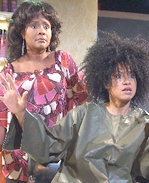SITE GUIDE
SEARCH
ADVERTISING AT CURTAINUP
REVIEWS
FEATURES
NEWS
Etcetera and
Short Term Listings
LISTINGS
Broadway
Off-Broadway
NYC Restaurants
BOOKS and CDs
OTHER PLACES
Berkshires
London
California
New Jersey
Philadelphia
Elsewhere
QUOTES
TKTS
PLAYWRIGHTS' ALBUMS
LETTERS TO EDITOR
FILM
LINKS
MISCELLANEOUS
Free Updates
Masthead
Writing for Us
A CurtainUp Los Angeles Review
And Her Hair Went With Her
|
In here we stick together. —Tonya Pinkins as convicted
murderer Felicia Miller
|

Tonya Pinkins and Tracie Thoms
|
The play is And Her Hair Went With Her, and don't be put off by that title, even though mention of it causes people to squinch up their faces and begin talking about what they had for dinner. The title, in fact, is the only off-key note in the entire play. Otherwise, playwright Zina Camblin's exploration of the many faces (and hair styles) of African-American women is perceptive, poignant, and powerful. And actresses Tonya Pinkins and Tracie Thoms bring it all to scintillating life.
Pinkins is Jasmine, the prototypical "big mama" owner of a beauty salon; Thoms is her assistant, Angie, a would-be writer, political activist, and single mom. What they share is a devotion to legendary singer Nina Simone, the "High Priestess of Soul," and a sensitivity to the quirks and attitudes of their varied clientele.
n Idol.
In quick succession, with a change of wigs and accents, they become Crystal, the self-negating black woman who revels in her story of "the day I became white." Also a self-styled BOC (Black Obsessive Compulsive) who readily exhibits examples of her manic disorder. Plus a drama queen who involves Jasmine in her preparations for an acting audition, which turns into a hilarious parody of American Idol. And finally, a much-fired secretary with attitude, who answers the phone from her salon chair as if she were in her office, and provides rudely bizarre responses to the callers.
There is serious talk as well about Black Panther intellectual Angela Davis; about the African-American search for individual identity, as expressed by a plethora of explicitly "different" names given to a whole generation of black children; and English as spoken by street- smart African-Americans. ("Ebonics is not our roots," Angie protests.) In a moving subplot, Angie interviews Felicia Miller, a jailed infamous lesbian-murderer (played by a street-tough Pinkins).
All of this is handled with deceptive simplicity by Obie Award-winning director Diane Rodriguez, who has her actresses snatch off each other's wigs, mount them on the mannequin heads scattered on shelves around the stage, and finally don the distinctive wig that will turn them into their next persona.
Conducted in near-blackout conditions, as provided by lighting designer Tony Mulanix, the wig and costume changes are swift and efficient, and startlingly effective in their transition to the introduction of a totally new character. The set by Sandra Burns is a marvel of authenticity, a perfect replica of a beauty salon—from its checker-patterned linoleum to the many spray cans and bottles lining the shelves.
The Fountain Theatre, which has mounted a couple of unexpected clunkers in recent years, has returned to its former glory as one of the best damned intimate theaters in Los Angeles. Congratulations to artistic directors Deborah Lawlor and Stephen Sachs and producing director Simon Levy.
Editor's note: The play has already had another production in New Jersey. To read that review go here
|
And Her Hair Went With Her By Zina Camblin Directed by Diane Rodriguez Cast: Tonya Pinkins (Jasmine), Tracie Thoms (Angie) Set Design: Sandra Burns Costume Design: Sandra Burns Lighting Design: Tony Mulanix Sound Design: Adam Phalen Running Time: one hour and 20 minutes without intermission The Fountain Theatre presents a National New Play Network World Premiere, The Fountain Theatre, 5060 Fountain Avenue, Los Angeles, (323) 663-1525, www.FountainTheatre.com From 04/25/08 to 06/15/08; opening 05/09/08 Tickets: $25; Seniors over 62 (Thursdays and Sundays only) $23; Students with ID: $18. Reviewed by Cynthia Citron based on 05/09/08 performance |
|
REVIEW FEEDBACK Highlight one of the responses below
Paste the highlighted text into the subject line: Feel free to add detailed comments in the body of the email. |





